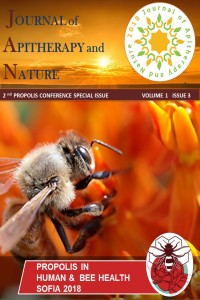Chemical Profiling of Papua New Guinea Propolis and Assay its Antiprotozoal Activity
Öz
This study is
aimed to investigate the chemical profile and examine the in vitro efficacy of Papua new guinea (PNG) propolis and compounds
purified from it purified compounds against the protozoal parasites: Crithidia
fasciculate, Trypansoma congolense, Trypanosoma b. brucei and drug resistant
Trypanosoma brucei (B48), which cause diseases in humans and other animals as
well as insects. In addition. The samples were assayed for their toxicity
against human U937 cells in vitro.
profiling was conducted by using negative ion spray ESI (LC-MS) and indicated
that the ethanolic extract of PNG contained a series of
triterpenes. Principle components analysis (PCA) of the processed
LC-MS data collected was demonstrated the uniqueness in chemical composition of
the fractions prepared from the sample that were also active against the
parasites. Active principles were isolated by bioassay-led
fractionation, using medium pressure chromatographic (MPLC). Afterwards, by
using spectroscopic and spectrometric means, nine pure compounds were isolated
and the their structures were elucidated indicating that eight of them were
cycloartane type triterpenes. While the other one was a pentacyclic triterpene,
20 hydroxy betuline that was found to be the most active compound in
these assays. Growth curves of drug-resistant T. brucei at
concentrations ≥ EC50 showed that this compound was trypanostatic. Overall, the
PNG propolis and its fractions showed low toxicity on U937 cell growth and were
efficacious against kinetoplastid parasites.
Anahtar Kelimeler
Papua New Guinea Propolis Chemical Profiling Antiprotozoal Activity
Kaynakça
- .
Öz
Kaynakça
- .
Ayrıntılar
| Birincil Dil | İngilizce |
|---|---|
| Bölüm | 2nd Propolis Conference Special Issue |
| Yazarlar | |
| Yayımlanma Tarihi | 8 Aralık 2018 |
| Yayımlandığı Sayı | Yıl 2018 Cilt: 1 Sayı: 3 - 2nd Propolis Conference Special Issue |
Kaynak Göster
ASOS Index

